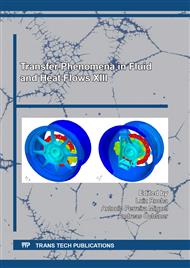[1]
T.G. Elizarova, Quasi-Gas Dynamic Equations. Springer-Verlag, Berlin, Heidelberg, (2009).
Google Scholar
[2]
Yu.V. Sheretov, Mathematical models of hydrodynamics, Tver: TvSU, (in Russian), (2004).
Google Scholar
[3]
About Ecological Sciences | United Nations Educational, Scientific and Cultural Organization, Information on http://www.unesco.org/new/en/natural-sciences/environment/ecological-sciences/ about-ecological-sciences/.
Google Scholar
[4]
On environmental protection: Federal Law of 10.01.2002 No. 7-FL; edition from 09.03.2021, Collected Legislation of the Russian Federation, № 2, Art. 133, (2002).
Google Scholar
[5]
G.V. Lepesh, E.I. Gritsay, V.A. Hotulev, Study the essence of electrochemical process, as the technological component of the water purification, J. Technico-tehnologicheskie problemy servisa, (in Russian), №2 (24), (2013) 42-49.
Google Scholar
[6]
V. I. Shvets, Preparation of deuterated inosine suitable for biomedical application / V. I. Shvets, A. M. Yurkevich, O. V. Mosin, D. A. Skladnev, Journal of Medical Sciences, Vol. 8, № 4, (1995) 231-232.
Google Scholar
[7]
O.V. Mosin, Deuterium, heavy water, evolution and life, J. Water treatment, water treatment, water supply, № 8, (in Russian), (2009) 64-70.
Google Scholar
[8]
O.V. Mosin, Study of amino acid biosynthesis by the facultative methylotroph of Brevibacterium methylicum on media containing heavy water, J. Biotechnology, № 3, (in Russian), (1996) 3-12.
Google Scholar
[9]
A. Szkatula, Magnetic treatment of industrial water. Silica activation / A. Szkatula, M. Balanda, M. Kopec, The European Physical Journal Applied Physics, № 18, (2002) 41-49.
DOI: 10.1051/epjap:2002025
Google Scholar
[10]
Zh. Jia, Preparation and application of novel magnetically separable γ-Fe 2O 3/activated carbon sphere adsorbent / Zh. Jia, K. Peng, Ya. Li, R. Zhu, J. Materials Science and Engineering:B, № 176 (11), (2011) 861-865.
DOI: 10.1016/j.mseb.2011.04.010
Google Scholar
[11]
F. Alimi, Effect of magnetic water treatment on calcium carbonate precipitation: Influence of the pipe material / F. Alimi, M.M. Tlili, M. Ben Amor, G. Maurin, C. Gabrielli, J. Chemical Engineering and Processing: Process Intensification, № 48 (8), (2009) 1327-1332.
DOI: 10.1016/j.cep.2009.06.008
Google Scholar
[12]
J. M. D. Coey, Magnetic Water Treatment / J.M.D Coey, S. Cass, Journal of Magnetism and Magnetic Materials, № 209(1), (2000) 71-74.
DOI: 10.1016/s0304-8853(99)00648-4
Google Scholar
[13]
V.F. Ochkov, Magnetic water treatment: history and current state, Energy saving and water treatment, 2006, № 2, Information on http://twt.mpei.ac.ru/ochkov/mo/art_ev/. (in Russian).
Google Scholar
[14]
V.F. Ochkov, Water and magnet, J. Water purification, Water treatment, Water supply, № 10, (in Russian), (2011) 36-48.
Google Scholar
[15]
N.V. Miklashevsky, S.V. Korolkova, Pure water. Cleaning systems and domestic filters. - SPb: BHV – St. Petersburg, Publishing group" Artlit ,, (in Russian), (2000).
Google Scholar
[16]
Yu.V. Sheretov, Regularized equations of hydrodynamics, Tver: TvSU, (in Russian), (2004).
Google Scholar
[17]
N.I. Tarasov, S.V. Polyakov, Yu.N. Karamzin, T.A. Kudryashova, V.O. Podryga, D.V. Puzyrkov, Incompressible Viscous Flow Simulation Using the Quasi- Hydrodynamic Equations' System, J. Mathematical Models and Computer Simulations, Vol. 12, No. 4, pp.553-560.
DOI: 10.1134/s2070048220040183
Google Scholar
[18]
R. Eymard, T.R Gallouet, R. Herbin, The finite volume method. Handbook of Numerical Analysis, Amsterdam, North Holland, 7, (2000), 713-1020.
Google Scholar
[19]
Basic meshing algorithms, Mesh 9.6.0 documentation, Information on https://docs.salome-platform.org/latest/gui/SMESH/basic_meshing_algos.html.
Google Scholar
[20]
Yu. Karamzin, T. Kudryashova, V. Podryga and S. Polyakov. Two-Scale Computation of N2-H2 Jet Flow Based on QGD and MMD on Heterogeneous Multi-Core Hardware, J. Advances in Engineering Software, Information on http://dx.doi.org/10.1016/j.advengsoft.2016.02.005 ISSN 0965-9978.
DOI: 10.1016/j.advengsoft.2016.02.005
Google Scholar
[21]
T. Kudryashova, S. Polyakov, N. Tarasov, Application of the Double Potential Method to Simulate Incompressible Viscous Flows. In: Rodrigues J. et al. (eds) Computational Science – ICCS 2019. Lecture Notes in Computer Science, vol 11539. Springer, Cham. Information on https://doi.org/10.1007/978-3-030-22747-0_42 (pp.568-579).
DOI: 10.1007/978-3-030-22747-0_42
Google Scholar
[22]
Sergey Polyakov, Tatiana Kudryashova, and Nikita Tarasov. Optimization of Parallel Computations for Modeling Water Purification Processes by Electromagnetic Method / EngOpt 2018 Proceedings of the 6th International Conference on Engineering Optimization (Editors H.C. Rodrigues, J. Herskovits, C.M. Mota Soares, A.L. Araujo, J.M. Guedes, J.O. Folgado, F. Moleiro, J. F. A. Madeira), pp.754-765. - Springer, Cham, 2019. 1486 p.
DOI: 10.1007/978-3-319-97773-7_66
Google Scholar
[23]
Tatiana Kudryashova, Sergey Polyakov and Nikita Tarasov . A novel parallel algorithm for 3D modelling electromagnetic purification of water. / MATEC Web of Conferences, 2018, paper 04027. 22nd International Conference on Circuits, Systems, Communications and Computers. N. Mastorakis, V. Mladenov and A. Bulucea (Eds.) Published online: 21 October 2018. Information on https://doi.org/10.1051/matecconf/201821004027.
DOI: 10.1051/matecconf/201821004027
Google Scholar


